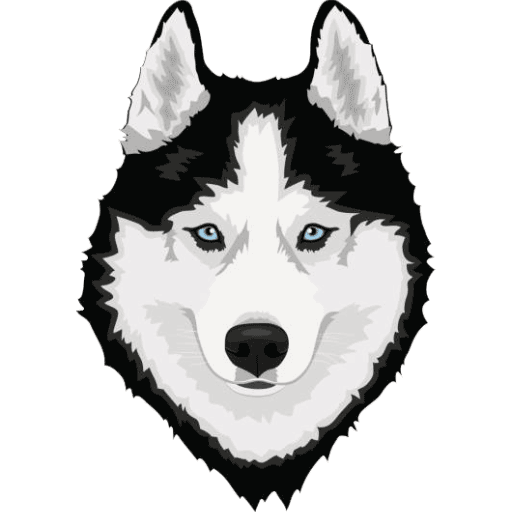If you’re thinking of getting a Siberian Husky or you already have a Husky puppy, you might wonder how big Huskies get. Knowing how big a full-grown Husky can get is important as it plays a big role in exercise requirements and diet.
Huskies are generally considered to be a medium-to-large dog breed, but like all animals, they can range in size.
Male Huskies are usually 21 to 23 inches tall (54 to 60 cm), and weigh between 44 and 60 lbs (20 – 27 kg) as adults. Female Huskies are usually 20 to 22 inches tall (50 – 56 cm), and weigh between 35 and 50 lbs (16 – 23 kg) as adults.
These figures are only averages as it is also possible to find Huskies that are larger or smaller than this, particularly if they are not purebred.
As you can see from the above figures, female Huskies are only slightly smaller on average compared to male Huskies. While female Huskies are only slightly smaller, they do tend to weigh a lot less on average. But it is possible to have female Huskies that are larger and weigh more than male Huskies.
Here is a diagram showing the average size difference between a female Husky (pink) and a male Husky (blue):
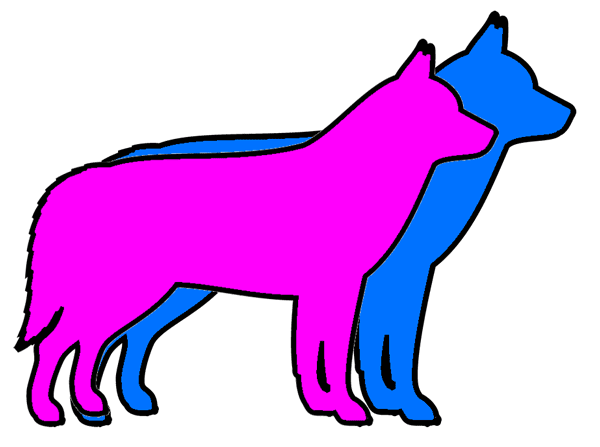
Another reason some Huskies may be larger than others is because of the way they were bred.
For example, a Husky who has been bred specifically for pulling sleds may be significantly larger than a Husky that has been bred to be a family pet. They are both still pure-bred, but the breeder has paired up Huskies to try and get the specific requirements they need for the Husky they want.
So if your Husky is bigger or smaller than the above ranges, it doesn’t necessarily mean your Husky is under or overweight.
How Big Huskies Get in a Year
If you have a Husky puppy, you might be surprised by how quickly they grow and how big they will get within a year.
Huskies usually grow to their full adult height within a year. They then continue to fill out as time goes on. When you first get a Husky puppy, you need to keep in mind that unless they are a Miniature Husky breed, they are very likely to grow to over double their size in the space of twelve months. Your Husky won’t be little forever!
For example, here’s what Sasha looked like as a young puppy:
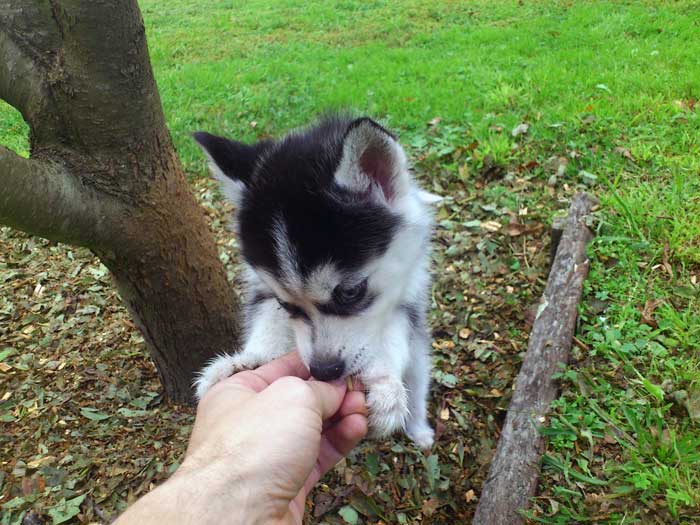
Here she is again after a year:
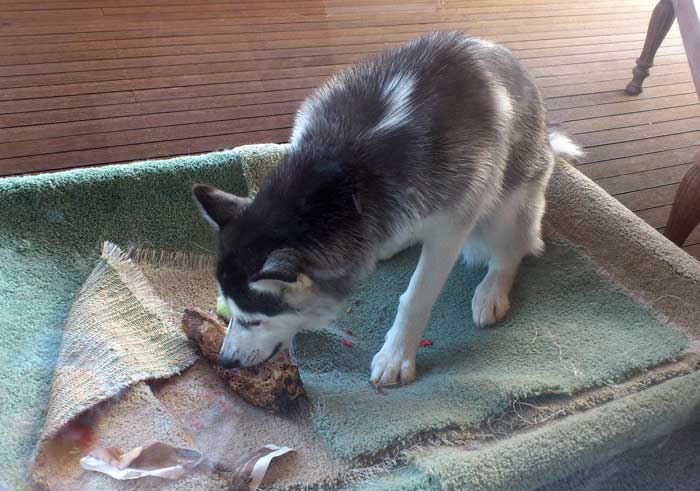
You can tell she’s still a young Husky by looking at the long white fur on her back. As she continues to grow, she will fill out and the fur will also slightly change.
While a Husky won’t really grow taller after the first year, they will fill out and that’s exactly what happened with Sasha after this photo.
Husky vs Malamute size
While Malamutes and Huskies are very similar, Malamutes are by far the larger dog breed. They usually stand around an inch taller than Huskies and can weigh up to 48 lbs (22kg) more.
People are often confused by the differences between Huskies and Malamutes and mistake one for the other. The below photo shows the typical difference in size of a Husky vs a Malamute.
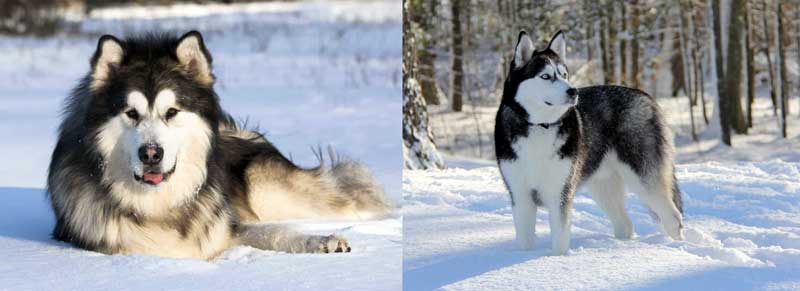
As you can see, Malamutes are thicker and fluffier while Huskies tend to be quite lean. While it’s possible to have a thick Husky, they’re typically smaller and thinner than Malamutes.
As you might expect, a mixed breed Husky/Malamute will share a lot of characteristics of both breeds.
How to Tell if Your Husky is Overweight
Because Huskies have thick fur (especially during the winter months), it can sometimes be difficult to tell if they are overweight. You can tell if your Husky is overweight by running your hands along their sides. If you can’t easily feel their ribs, it means that they’re overweight. You know your Husky is obese if you can’t see a waistline at all.
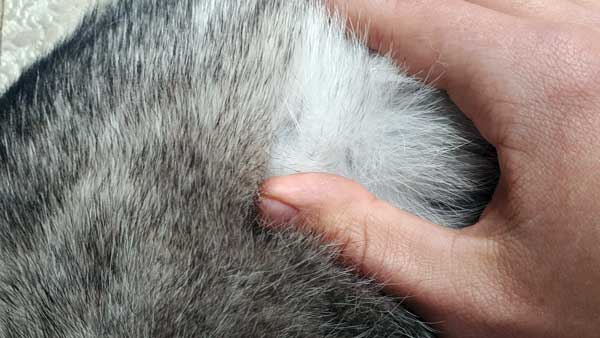
Keep in mind that your Husky will have a thicker coat during winter, so don’t immediately panic if you feel a difference in your Husky in the colder months. Learn more about a Husky’s double coat in this article. Huskies can also put on weight during winter – partially due to the environment and partially due to owners exercising their Huskies less in colder months.
A way to combat weight gain is by making sure that your Husky has a healthy and nutritious diet, and is exercised regularly. Being careful with food portions and going for regular walks can make a huge difference to the weight of your Husky.
Keep in mind that as explained earlier, some Huskies will be heavier than average due to selective breeding. Some breeders aim to produce larger Huskies for pulling sleds. A friend of mine has a female Husky who weighs 70 lbs (32kg) but is lean and healthy.
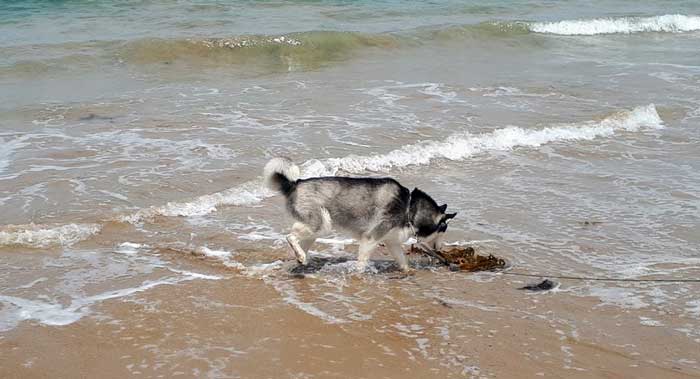
You can’t tell from the above photo, but that’s a 70 lbs Husky and she towers over my average size Husky.
Keeping Your Growing Husky Healthy
Diet and exercise are important to avoid your Husky becoming overweight, but they’re also important factors to consider if you want your Husky to grow up strong and healthy.
A good diet will help support your Husky’s growth and avoid problems. Just like humans, it is easy for Huskies to put on weight and develop health problems because of this.
Keeping active and eating nutritious meals can make a huge difference in the overall health of your Husky.
Find out about what foods Huskies can eat in this guide. Understanding what foods can cause your Husky to gain weight makes it easier to keep your Husky in a healthy weight range.
Husky vs Miniature Husky Size
If you have always wanted a Husky but were concerned about their size, you may have also come across Miniature Huskies, which have been bred to be significantly smaller.
As adults, Miniature Huskies are less than half the size of regular Huskies. They usually weigh up to 35 lbs (16kg), and stand at approximately 16 inches (40cm) tall, placing them in the smaller-dog category.
As you can imagine, these Miniature Huskies are significantly smaller than a normal Husky.
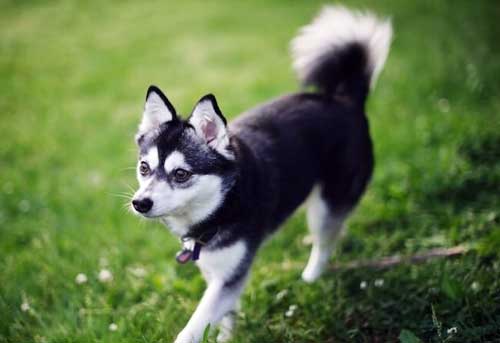
Miniature Huskies have a similar temperament and appearance to regular-sized Huskies and are also fantastic pets for people who are looking for a smaller-sized Husky.
The smaller size of a Miniature Husky means that the exercise requirements are far lower. This makes Miniature Huskies perfect for people who aren’t able to provide a regular-sized Husky the exercise they need.
Here is a rough diagram showing the typical size difference between a regular Husky and a Miniature Husky:

Keep in mind that the actual difference depends on the breeders.
Miniature Huskies are genetically identical as regular-sized Huskies, so they can experience the same health issues and have the same dietary requirements. This means you should look at feeding your Miniature Husky the same food recommended for regular-size Huskies (although at a much smaller quantity). Dog food cans designed for small dog breeds aren’t suitable.
There are many other mixed breed Huskies out there that can vary significantly in size. If you have a Husky crossed with another breed, take a look at what the other breed is to give you a rough idea of the size your Husky may grow to.
